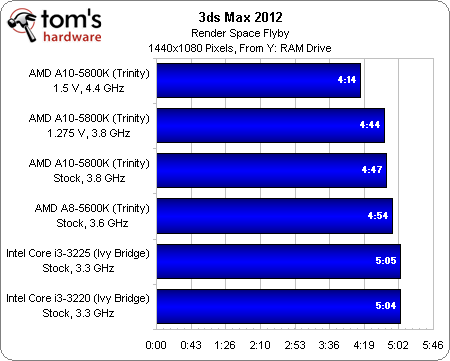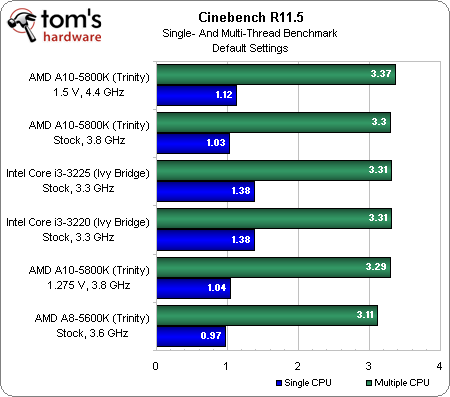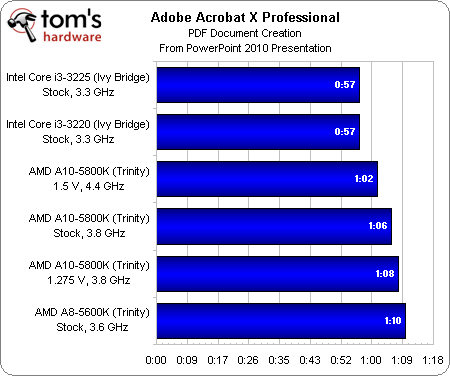AMD's Trinity APU Efficiency: Undervolted And Overclocked
We've been playing with AMD's Trinity APUs for four months, and they're just now being rolled out to the channel. This time, we take a look at the architecture's efficiency compared to a pair of Ivy Bridge-based Core i3s. Can A10 and A8 stand up to Intel?
Benchmark Results: Content Creation
Able to use as many x86 cores as you throw at it, 3ds Max gives the edge to AMD’s A10 and A8, though Intel’s Core i3s are only seconds behind.
Overclocking has a profound impact on performance in this test because, normally, the A10’s Turbo Core technology isn’t able to scale all the way up to 4.2 GHz when both modules are active. By setting a static 4.4 GHz clock rate, the APU’s x86 resources operate at a higher frequency even in the face of a taxing workload.
Based on Maxon’s Cinema 4D software, Cinebench is unique in that it allows us to isolate single- and multi-threaded performance.
Using it, we’re able to clearly see that Intel’s Ivy Bridge-based cores achieve much better performance than AMD’s Piledriver modules, even at significantly lower clock rates.
Truly, it takes parallelization to even out the field. Intel’s Hyper-Threading technology is designed to better-exploit underutilized processing resources, but it cannot overcome AMD’s approach, which exposes two complete integer cores per module.
In contrast, turning a PowerPoint document into an Adobe Acrobat file is not a task that gets divvied up across multiple cores. Intel’s powerful architecture consequently secures a victory that not even a Trinity-based APU at 4.4 GHz can overcome.
Get Tom's Hardware's best news and in-depth reviews, straight to your inbox.
Current page: Benchmark Results: Content Creation
Prev Page Benchmark Results: Adobe CS6 Next Page Benchmark Results: Productivity-
esrever Most PC are idle or semi idle when people have them on. 90% of the time I use my PC, I do web surfing or watch video or a text editor for work, my pc is not loaded with benchmarks 24/7. If you look at idle power consumption, the trinity APUs are amazing. They easily beat out intels offerings. If you are looking at the power consumption over a month, the trinity will be much more energy efficient than the i3 for most people.Reply
-
tacoslave man getting this in a 17inch laptop with a 12 cell battery would make it an instabuyReply -
mayankleoboy1 ReplyIn the end, then, both Intel and AMD are offering you an experience. Which one do you pick?
At this price point, i would choose AMD Trinity. -
cangelini esreverMost PC are idle or semi idle when people have them on. 90% of the time I use my PC, I do web surfing or watch video or a text editor for work, my pc is not loaded with benchmarks 24/7. If you look at idle power consumption, the trinity APUs are amazing. They easily beat out intels offerings. If you are looking at the power consumption over a month, the trinity will be much more energy efficient than the i3 for most people.Happy to set a couple of systems up and let you know what I find.Reply -
mayankleoboy1 AMD should team up with developer of 7zip to accelerate it on APU's. That will make Trinity look better. A lot of people use 7zip. And most of the installation setup exe files are compressed using LZMA algorithm.Reply -
mayankleoboy1 Chris, it would be great to see some benchmarks of applications that uses the new FMA3 instructions of the Piledriver.Reply -
cangelini esreverMost PC are idle or semi idle when people have them on. 90% of the time I use my PC, I do web surfing or watch video or a text editor for work, my pc is not loaded with benchmarks 24/7. If you look at idle power consumption, the trinity APUs are amazing. They easily beat out intels offerings. If you are looking at the power consumption over a month, the trinity will be much more energy efficient than the i3 for most people.So, it's probable that we're seeing a difference in configuration. It looks like Anand is using the Gigabyte A85X board and perhaps an older driver version. I'm on the MSI board and Cat 12.8, with a different Intel setup as well. On the Windows desktop, after 10 minutes on each config, I get 59 W for Intel and 67 W for AMD at idle.Reply -
techcurious Chris, for the sake of completeness, any chance you could undervolt the i3-3225 at stock speeds and run the power consumption/efficiency tests on it? ;) ...to reveal how low the i3 can be pushed with some tweaking as well, and create the opportunity for a more fair comparison with the undervolted Trinity results.Reply -
sarinaide Thanks Chris, another great article to pass time over. You really need to comment on the forums more and more so to help out against the blatent belligerence against what AMD are trying to achieve and how they are looking to achieve it.Reply
Hopefully this articale can start to filter around particularly for the budget users which A-series is premised to target.



